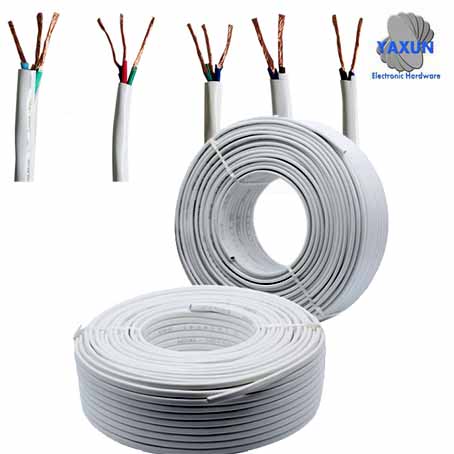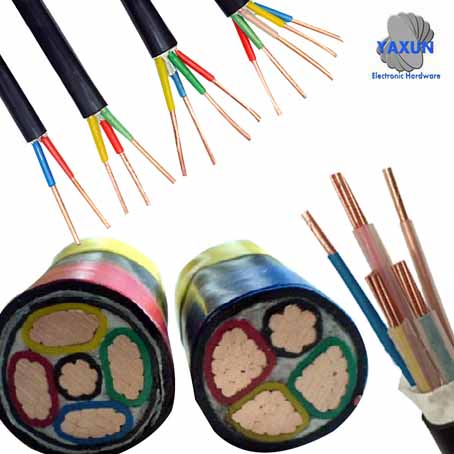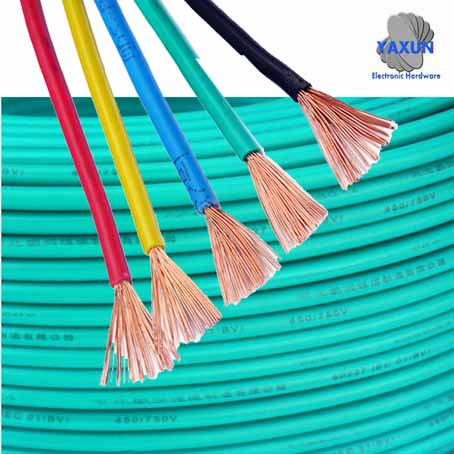China Flame Retardant Cable Manufacturer
What is a flame-retardant cable? Its characteristics and applications.

Flame-retardant cable means that the cable is burned under the specified test conditions. After the fire source is removed, the flame spread is only within a limited range. A cable that can extinguish the flame itself within a limited time. The fundamental feature is: it may be burned out but not work in a fire situation, but it can prevent the spread of the fire. In layman's terms, if a wire catches a fire, it can limit the combustion to a local area without spreading, and protect other equipment and avoid greater losses.
The meaning of cable flame retardant:
Burn the cable under the specified test conditions. After the fire source is removed, the flame spreads only within a limited range and extinguishes itself, that is, it has the ability to prevent and delay the occurrence or spread of flames. The burning of wires and cables is caused by external heating to produce flammable gas. To achieve the purpose of flame retardancy, the three elements that cause combustion must be suppressed, namely: combustible gas, heat and oxygen. Therefore, the method generally used for flame-retardant wires and cables is to add halogen-containing halides and metal oxides to the sheath material. From the perspective of flame retardancy, this is an excellent method. However, because these materials contain halides, they release a large amount of smoke and hydrogen halide gas during combustion. Therefore, the visibility during a fire is low, which greatly hinders the safe evacuation of personnel and fire fighting, and more people are suffocated to death by toxic gases.In addition, once the hydrogen halide gas reacts with water in the air, "hydrohalide acid" is generated, which severely corrodes equipment and buildings, causing "secondary disasters."
With the continuous improvement of the level of science and technology, the flame retardant problem has been further developed from halogen flame retardants in the past to low halogen, halogen-free flame retardants.
Type of flame-retardant cable
| Copper core | Aluminum core | Name | use |
| ZA-YJV/ZB-YJV/ZC-YJV | ZA-YJLV/ZB-YJLV/ZC-YJLV | XLPE insulated PVC sheathed Class A (B, C) flame-retardant power cable | It can be laid in indoors, tunnels and pipelines where flame retardancy is required. |
| ZA-YJV22/ZB-YJV22/ZC-YJV22 | ZA-YJLV22/ZB-YJLV22/ZC-YJLV22 | XLPE insulated steel tape armored PVC sheathed Class A (B, C) flame-retardant power cable | It is suitable for laying in the ground when flame retardant is required, but not suitable for laying in pipelines. |
| ZA-VV/ZB-VV/ZC-VV | ZA-VLV/ZB-VLV/ZC-VLV | Polyvinyl chloride insulated and PVC sheathed A (B, C) flame-retardant power cable | It can be laid in indoors, tunnels and pipelines where flame retardancy is required. |
| ZA-VV22/ZB-VV22/ZC-VV22 | ZA-VLV22/ZB-VLV22/ZC-VLV22 | PVC insulated steel tape armored PVC sheathed Class A (B, C) flame-retardant power cable | It is suitable for buried laying when flame retardant is required, but not suitable for laying in pipelines. |
| WDZA-YJY/WDZB-YJY/WDZC-YJY | WDZA-YJLY/WDZB-YJLY/WDZC-YJLY | XLPE insulated polyolefin sheathed A (B, C) flame-retardant power cable | It can be installed in indoors, tunnels and pipelines that require flame retardant, halogen-free and low-smoke. |
| WDZA-YJV23/WDZB-YJV23/WDZC-YJV23 | WDZA-YJLV23/WDZB-YJLV23/WDZC-YJLV23 | XLPE insulated steel tape armored polyolefin sheathed Class A (B, C) flame-retardant power cable | It is suitable for laying in the ground when flame-retardant, halogen-free and low-smoke are required, but not suitable for laying in pipelines. |
Flame retardant grade of the cable
1. Finished cable conductor (Class R) DC resistance (in accordance with GB3956)2. Power frequency voltage test: AC 50HZ3.5KV/5min without breakdown

IEC flame retardant grade
In order to evaluate the flame-retardant performance of cables, the International Electrotechnical Commission has formulated three standards: IEC60332-1, IEC60332-2 and IEC60332-3. IEC60332-1 and IEC60332-2 are used to evaluate the flame retardancy of a single cable when placed in an inclined and vertical position (corresponding to GB12666.3 and GB12666.4 standards in China). IEC60332-3 (corresponding to GB12666.5-90 in China, GB12666.5 has been replaced by GB/T 18380.3-2001) is used to assess the flame retardancy of bundled cables when they are burnt vertically. In contrast, the flame retardant requirements of bundled cables are much higher when they burn vertically.
◎ IEC60332-1/BS4066-1 flame retardant rating (Flame Test On Single Vertical Insulated Wires/Cables).
This is the flame retardant standard for a single cable. The test stipulates that a 60 cm long sample is vertically fixed in a metal box with an open front wall. A propane burner with a flame length of 175 mm is located 450 mm from the upper fixed end of the sample, and the flame cone is in contact with the cable at an angle of 45 degrees. If the burning damage of the sample is not more than 50mm from the lower part of the fixed end, the test passes.
◎ IEC60332-3/BS4066-3 flame retardant rating (Flame Test On Bunched Wires/Cables)
This is the flame retardant standard for bundled cables. The test stipulates that a bundle of 3.5m long cable samples is fixed on a trapezoidal test frame with iron wires. The number of samples is determined by the non-metallic materials required by different classifications. The sample is hung vertically on the back wall of the combustion furnace, and air is introduced into the combustion furnace through the air inlet on the bottom plate. The propane plane burner was in contact with the sample with a flame at 750°C. When the sample is forced to blow (air discharge 5m3/min, wind speed 0.9m/sec), it must not burn within 20 minutes of vertical combustion. The cable extinguishes itself within 2.5 meters of flame spread. IEC60332 is divided into Class A, Class B, Class C and Class D to assess the pros and cons of flame retardant performance.

UL flame retardant standard
Any flame-retardant cables according to UL standards have been tested and verified. Meet a certain flame-retardant grade, UL identification, flame-retardant grade and approval number can be printed on the cable.
◎ Supercharged level-CMP level cable (supply air combustion test / Steiner tunnel test Plenum Flame Test / Steiner Tunnel Test)
This is the most demanding cable (Plenum Cable) in the UL fire protection standard, and the applicable safety standard is UL910. The experiment stipulates that multiple samples are laid on the horizontal air duct of the device and burned with a 87.9KW gas Bunsen burner (300,000BTU/Hr) for 20 minutes. The eligibility criterion is that the flame cannot extend beyond 5 feet from the front end of the gas Bunsen burner. The peak value of the optical density is at most 0.5, and the average density value is at most 0.15. This kind of CMP cable is usually installed in the air return pressurization system used in ventilation ducts or air handling equipment, and is approved for use in Canada and the United States. FEP/PLENUM materials conforming to UL910 standard have better flame retardancy than low-smoke halogen-free materials conforming to IEC60332-1 and IEC60332-3 standards, and the concentration of smoke when burned is lower.
◎ Trunk level-CMR level cable (Riser Flame Test)
This is a commercial grade cable (Riser Cable) in the UL standard, and the applicable safety standard is UL1666. The experiment stipulated that multiple samples were laid on the simulated vertical shaft, and the stipulated 154.5KW gas Bunsen burner (527,500BTU/Hr) was used for 30 minutes. The eligibility criterion is that the flame cannot spread to the upper part of a 12-foot-high room. There is no smoke density specification for trunk-level cables, and they are generally used for vertical and horizontal wiring on floors.
◎ Commercial grade-CM grade cable (Vertial Tray Flame Test)
This is a general purpose cable in the UL standard, and the applicable safety standard is UL1581. The experiment stipulates that multiple samples are laid on a vertical stand of 8 feet high, and burned with a prescribed 20KW belt burner (70,000BTU/Hr) for 20 minutes. The qualification standard is that the flame cannot spread to the upper end of the cable and extinguish itself. UL1581 is similar to IEC60332-3C, except that the number of cables to be laid is different. Commercial-grade cables do not have smoke density specifications, and are generally only used for horizontal wiring on the same floor, not for vertical wiring on the floor.
◎ Household grade-CMX grade cable (Vertial Wire Flame Test)
This is a household-grade cable (Restricted Cable) in the UL standard, and the applicable safety standard is UL1581, VW-1. The experiment stipulates that the sample should be kept vertical, burned with the test burner (30,000 TU/Hr) for 15 seconds, then stopped for 15 seconds, and repeated 5 times. The eligibility standard is that the residual flame should not exceed 60 seconds, the sample should not be burned by more than 25%, and the coat cotton on the bottom should not be ignited. UL1581-VW-1 is similar to IEC60332-1, except that the burning time is different. This level also has no smoke or toxicity specifications, and is only used in home or small office systems where a single cable is laid. This kind of cables should not be used in bundles and must be isolated by casing. Smoke density, halogen content and toxicity level.





